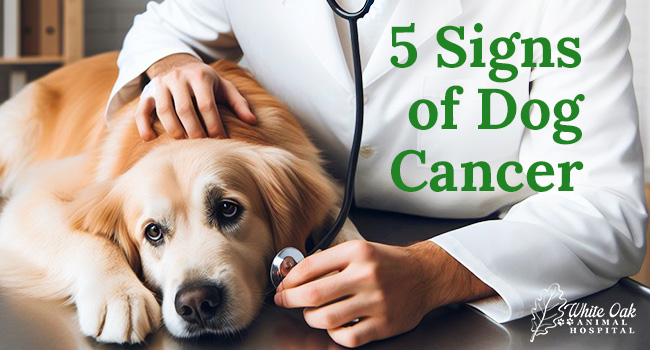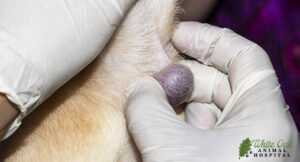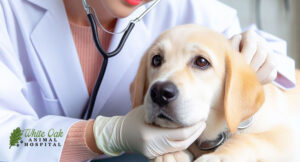
Dog cancer is, unfortunately, a prevalent concern among canine companions. It affects a significant number of dogs across the globe. As responsible pet owners, it’s crucial to be aware of this condition’s prevalence and its potential risks to our furry friends. Early detection plays a pivotal role in effectively managing and treating dog cancer. Despite its prevalence, there are many myths and misconceptions surrounding this topic.
It’s essential to debunk these myths to ensure accurate understanding and proactive measures for our pets’ well-being. In this section, we will delve into the prevalence of dog cancer, highlighting the significance of early detection and addressing common misconceptions surrounding this condition. By understanding better, we can empower ourselves to provide the best possible care for our beloved canine companions.
Understanding Dog Cancer
 Dog cancer refers to the abnormal growth of cells within a dog’s body, leading to the formation of tumors or masses. These growths can be benign or malignant, with malignant tumors being cancerous and capable of spreading to other body parts. Understanding the nature of dog cancer is vital for pet owners to recognize potential symptoms and seek timely veterinary care.
Dog cancer refers to the abnormal growth of cells within a dog’s body, leading to the formation of tumors or masses. These growths can be benign or malignant, with malignant tumors being cancerous and capable of spreading to other body parts. Understanding the nature of dog cancer is vital for pet owners to recognize potential symptoms and seek timely veterinary care.
Several factors contribute to the development of dog cancer, including genetic predisposition, environmental factors, and age. Certain breeds are also more prone to specific types of cancer, highlighting the role of genetics in canine cancer susceptibility. Environmental factors such as exposure to toxins or carcinogens can also increase the risk of cancer in dogs. Additionally, age is a significant factor, with older dogs being more susceptible to developing cancerous growths. By understanding these factors, pet owners can take proactive measures to minimize risks and promote their dog’s health and well-being.
Signs and Symptoms
 Persistent lumps and bumps: One of the primary signs of dog cancer is the presence of persistent lumps or bumps on your dog’s body. These may appear suddenly or gradually increase in size over time. While not all lumps are cancerous, a veterinarian must examine any new or unusual growths to rule out the possibility of cancer.
Persistent lumps and bumps: One of the primary signs of dog cancer is the presence of persistent lumps or bumps on your dog’s body. These may appear suddenly or gradually increase in size over time. While not all lumps are cancerous, a veterinarian must examine any new or unusual growths to rule out the possibility of cancer.- Unexplained weight loss or loss of appetite: Dogs with cancer often experience unexplained weight loss despite maintaining their regular diet. Additionally, a sudden loss of appetite or reluctance to eat can indicate underlying health issues, including dog cancer. Monitoring your dog’s eating habits and addressing any significant changes promptly is essential for early detection and intervention.
- Changes in behavior or activity levels: Cancer can affect a dog’s behavior and activity levels. You may notice your dog becoming lethargic, less interested in activities they once enjoyed or exhibiting unusual behaviors such as restlessness or irritability. A veterinarian should evaluate any significant changes in your dog’s behavior to determine the underlying cause, which could include dog cancer.
 Difficulty breathing or urinating: Certain types of dog cancer, such as lung or bladder cancer, can cause difficulty breathing or urinating. If your dog experiences labored breathing, coughing, or wheezing or shows signs of straining or pain while urinating, it’s essential to seek immediate veterinary attention. These symptoms may indicate a severe underlying condition that requires prompt diagnosis and treatment.
Difficulty breathing or urinating: Certain types of dog cancer, such as lung or bladder cancer, can cause difficulty breathing or urinating. If your dog experiences labored breathing, coughing, or wheezing or shows signs of straining or pain while urinating, it’s essential to seek immediate veterinary attention. These symptoms may indicate a severe underlying condition that requires prompt diagnosis and treatment.- Chronic pain or discomfort: Dogs with cancer may experience chronic pain or discomfort, manifesting in various ways. You may notice your dog limping, favoring certain limbs, or exhibiting signs of discomfort when touched or handled. Other signs of pain may include whining, panting, or changes in posture. It’s crucial to monitor your dog for signs of pain and discomfort and consult a veterinarian to determine the best action for managing their symptoms and improving their quality of life.
Recognizing the signs and symptoms of dog cancer is essential for pet owners to ensure the timely diagnosis and treatment of this disease. By remaining vigilant and proactive in monitoring your dog’s health and seeking veterinary care for any concerning changes or symptoms, you can help improve their chances of a positive outcome and provide them with the care and support they need.
Spotting Symptoms
 Spotting symptoms of dog cancer requires a proactive approach from pet owners. Regular physical examinations by a qualified veterinarian are crucial for detecting any early signs of the disease. These routine check-ups allow for thorough assessments of your dog’s overall health and help identify any abnormalities or suspicious lumps that may indicate dog cancer.
Spotting symptoms of dog cancer requires a proactive approach from pet owners. Regular physical examinations by a qualified veterinarian are crucial for detecting any early signs of the disease. These routine check-ups allow for thorough assessments of your dog’s overall health and help identify any abnormalities or suspicious lumps that may indicate dog cancer.
Awareness of breed-specific predispositions to certain types of cancer can aid in early detection. Different dog breeds may have a higher risk of developing specific types of cancer, making it essential for pet owners to educate themselves about their dog’s breed and any associated health concerns.
Debunking Myths and Misconceptions
 In dog cancer, misinformation often abounds, leading to confusion and unnecessary worry among pet owners. Debugging common myths and misconceptions surrounding this topic is crucial to foster a more precise understanding and informed decision-making.
In dog cancer, misinformation often abounds, leading to confusion and unnecessary worry among pet owners. Debugging common myths and misconceptions surrounding this topic is crucial to foster a more precise understanding and informed decision-making.
One prevalent misconception is that dog cancer is solely caused by genetics. While genetics can play a role in predisposing certain breeds to cancer, environmental factors such as exposure to carcinogens also contribute significantly.
Additionally, there are misconceptions about the causes and treatments of dog cancer. Some believe certain dietary supplements or alternative therapies can cure or prevent cancer in dogs. However, relying on evidence-based veterinary medicine to treat and manage the disease is essential.
Seeking Veterinary Care
Consulting a veterinarian allows for professional assessment and guidance tailored to your dog’s needs. Veterinary professionals possess the expertise to conduct thorough examinations and recommend appropriate diagnostic tests to confirm or rule out the presence of dog cancer.
Diagnostic tests may include imaging techniques such as X-rays, ultrasounds, or CT scans, as well as laboratory tests like blood work or biopsies. These tests help us accurately diagnose dog cancer and develop a personalized treatment plan based on the specific type and stage of the disease. Treatment options for dog cancer may vary depending on factors such as the type of cancer, its stage, and your dog’s overall health.
 Addressing concerns related to dog cancer requires proactive measures and informed decision-making. Consulting a trusted veterinary professional, such as White Oak Animal Hospital, is essential for accurate diagnosis and personalized treatment plans. White Oak Animal Hospital stands out by offering integrative options not available elsewhere, including TCVM Telemedicine consultations, backed by over 28 years of experience in the field.
Addressing concerns related to dog cancer requires proactive measures and informed decision-making. Consulting a trusted veterinary professional, such as White Oak Animal Hospital, is essential for accurate diagnosis and personalized treatment plans. White Oak Animal Hospital stands out by offering integrative options not available elsewhere, including TCVM Telemedicine consultations, backed by over 28 years of experience in the field.
Pet owners are encouraged to download the free dog cancer eBook for further guidance and support. This comprehensive resource provides information on various treatment options, including medical, holistic, and alternative approaches.
By empowering pet owners with knowledge and resources, we aim to help dogs and their owners navigate through this challenging journey with hope and confidence. Get your free copy today and take the first step towards supporting your dog’s health and well-being.
Frequently Asked Questions
What are the main types of Dog Cancer?
The main types of dog cancer include mast cell tumors, lymphoma, osteosarcoma, hemangiosarcoma, and mammary gland tumors. Each type may present with unique symptoms and require specific treatment approaches.
Can Dog cancer be prevented?
While there is no guaranteed way to prevent dog cancer, specific measures can help reduce the risk, such as maintaining a healthy diet, regular exercise, minimizing exposure to environmental toxins, and scheduling routine veterinary check-ups for early detection.
How is Dog Cancer diagnosed?
Dog cancer is diagnosed through physical examinations, imaging tests (such as X-rays, ultrasounds, or CT scans), blood work, and biopsies. These diagnostic tools help veterinarians determine the type, cancer’s location, and extent of its cancer treatment options for dog cancer.
Treatment options for dog cancer vary depending on factors such as the type of cancer, stage of cancer, and the dog’s overall health. Common treatment modalities may include surgery, chemotherapy, radiation therapy, immunotherapy, or palliative care.
What is the prognosis for Dog Cancer?
The prognosis for dog cancer varies depending on factors such as the type of cancer, its cancer diagnosis, and the effectiveness of treatment. Early detection and intervention generally result in better outcomes, but discussing prognosis with your veterinarian for personalized guidance is essential.
Related Posts
-
Top Dog Cancer Natural Remedies
Many natural dog cancer remedies are available today. Most dog cancer natural treatments can be…
-
How To Identify And Treat Dog Cancer
Dog cancer is an unfortunately common malady. Common causes of dog cancer include environmental pollution,…
-
Effective Relief For Allergic Dog Symptoms
An allergic dog is easy to spot! Sure, all dogs itch and scratch, but you…
-
Can Natural Dog Cancer Treatment Help Your Dog?: 5 Powerful Reasons to Try Integrative Methods
Many pet owners are now looking into available natural dog cancer treatments as a complementary…










